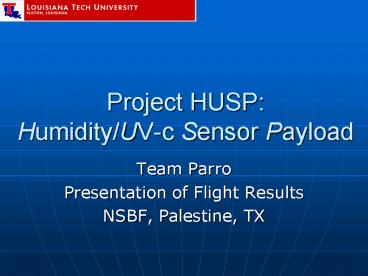Project HUSP: HumidityUVc Sensor Payload - PowerPoint PPT Presentation
1 / 16
Title:
Project HUSP: HumidityUVc Sensor Payload
Description:
The balloon sat circuit board resides in the smaller box and connect to the ... The data will be retrieved by running a program to print out the stored data ... – PowerPoint PPT presentation
Number of Views:23
Avg rating:3.0/5.0
Title: Project HUSP: HumidityUVc Sensor Payload
1
Project HUSPHumidity/UV-c Sensor Payload
- Team Parro
- Presentation of Flight Results
- NSBF, Palestine, TX
2
Team Members
- Josh Hignight Project manager and software
development - Jason Rollins Responsible for electrical work
including power consumption, sensor interfacing,
electrical design, and balloon sat testing - Matt VanKerhkove Thermal design and acquisition
of parts for thermal needs, as well as thermal
testing - Tim Butler In charge of things dealing with
constrution
3
Project Proposal
- Using a humidity, UV-c, and temperature sensor,
Team Parro will plot a graph of absolute humidity
vs. altitude, UV-c vs. altitude, and UV-c vs
humidity, in a hope to see a spike in absolute
humidity at the upper boundaries of the ozone
layer due to an increase in UV-c.
4
Science
- Ozone layer 19-48 km high
- UV-c cannot penetrate ozone layer
- Temperature rises where the ozone begins
5
Science
- Ozone absorbs UV between 200nm and 310nm
- This breaks up the ozone from
- O3 ? O2 O
- The O then forms with water to form two hydroxyl
molecules O H2O ? 2HO - Each of these OHs then form with methane, and
other pollutants to form water.
6
Humidity
Humidity and Temperature Dependence
NASAs UARS Project
Present Data on Humidity vs. Altitude
7
Sensors
- HOBO
- Boston Electronic UV sensor JEC.01C
8
Design
- The payload consist of two boxes, a UV sensor,
HOBO, balloon sat circuit board (includes EEPROM
chip, and processor), an analog to digital
converter, a 741 op-amp to buffer our UV sensor,
and a Lucite window. - The balloon sat circuit board resides in the
smaller box and connect to the sensors through
the ADC. HOBO will be outside of both the inner
and outer box, while the UV sensor will remain
inside the larger box. - Hand warmers will be placed inside the larger box
to keep the temperature above the electronics
operating temperature.
9
Payload Construction
10
Software
- Our program will read our UV sensor form CH2 of
the ADC every 3.25 seconds. - After every read, the current address counter
will be saved into address 0 of the 24128w6. - Before each read, the program will check itself
and shut down if there is not enough free space.
11
Testing
12
Mission Operations
- The software will be run and the box sealed. The
sensors will then begin collecting data and will
continue to do so until recover or when memory is
full. The payload will then be recovered and the
data collected from the EEPROM chip via a serial
connection.
13
Data Acquisition and Analysis
- The data will be retrieved by running a program
to print out the stored data onto the debug
screen. The data will then be copied and pasted
into excel where it will be calibrated and
plotted.
14
Budget
Expense Budget
Weight Budget
Object Weight(g) Electronics 107 Inner
Box 78.5 Outer Box 142.75 HOBO 20 Hand
Warmers 66 Battery 60 Lucite 20 Sensors Negl
igible Total Weight 494.25
Object
Price
Foam Board 5 Hand Warmers 4.50 Sensors 1
32 Electronics Provided Lucite
Free Wire 10 Batteries 20 T
otal 160
Power Budget
EEPROM 40mA ADC 15mA 24128w6 3m UV
sensor none Total mA 58mA Total running time
41 hours
15
Sources for Facts and Figures
- Sensor
- http//content.honeywell.com/sensing/prodinfo/humi
ditymoisture/009012_2.pdf - http//www.sensorsmag.com/articles/0701/54/main.sh
tml - Science
- http//www.igac.noaa.gov/newsletter/21/measurement
s.php - http//www.es.lancs.ac.uk/casestud/case13.htm
- http//www.indiana.edu/climate/g470/Lectures/Humi
dity/MoistAir.html - http//www.indiana.edu/climate/g470/Lectures/Humi
dity/MoistAir.html - http//www.grida.no/climate/ipcc_tar/wg1/080.htm
- NASA related projects and info
- http//svs.gsfc.nasa.gov/stories/humidity_20040315
/index.html - http//msis.jsc.nasa.gov/sections/section05.htm
- http//science.hq.nasa.gov/missions/satellite_25.h
tm - http//aqua.gsfc.nasa.gov/
- http//earthobservatory.nasa.gov/
- http//www.nasa.gov/home/hqnews/2003/dec/HQ_03394_
water_map.html - http//www.nasa.gov/home/hqnews/2004/mar/HQ_04090_
satellite_finds_warming.html
16
End
Questions ?































